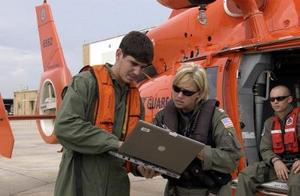Search and rescueRescue 21 bolsters Coast Guard's search-and-rescue capablilities
Rescue 21 is already covering portions of the U.S. coastline and, as of last week, officially includes the coasts of Maryland, Virginia, Washington, D.C., and the upper Chesapeake Bay

Position? Nature of distress? Description of the vessel? Number of people on board? Are people wearing their life jackets? These are the first five things a Coast Guard watchstander will ask when you make a distress call. Watchstanders call this data “the big 5,” as they are vital pieces of information needed during a search and rescue case.
LTJG Stephanie Young writes that a vessel’s position is the most crucial piece of information but sometimes the hardest to determine. Last week, ending a two year phase-in period, Coast Guard Sector Baltimore formally accepted Rescue 21, a new tool to help watchstanders determine a distressed mariner’s position.
Rescue 21 is already covering more than 35,000 miles of coastline in the United States and, as of last week, officially includes the coasts of Maryland, Virginia, Washington, D.C., and the upper Chesapeake Bay.
Recent search and rescue cases in the area show how valuable Rescue 21’s advanced capabilities can be. On 25 July, watchstanders at Sector Baltimore put Rescue 21 to the test as they responsed to thirty-seven distinct distress calls, resulting in more than seventy-seven people assisted or rescued — all in only a two-hour period.
An unexpected powerful storm suddenly erupted in Chesapeake Bay on a calm summer day, producing wind gusts and volatile sea conditions and catching mariners off guard. Mayday calls began pouring in to the Sector Baltimore command center. Using information gained from Rescue 21, watchstanders were able to determine locations of the distressed mariners and launch Coast Guard assets from six different small boat stations to respond to the calls for help.
Chief Lawrence Beatty, an Operations Specialist at Sector Baltimore, was first introduced to Rescue 21 eight years ago as part of a test bed, when the technology initially launched. Beatty is very familiar with the benefits Rescue 21 provides command center watchstanders.
“Right off the bat, a watchstander has a visual display so you are not only hearing the transmission but you are also seeing which towers are picking it up and in which direction,” Beatty told Young. “The towers are strategically placed so multiple towers can pick up and triangulate to where that mariner is.”
Young writes that, in a sense, Rescue 21’s direction-finding capabilities, as well as its increased range, allows command centers to better “hear” the call.
For a mariner in a dire situation, reaching for a handheld radio and calling “Mayday” over marine radio channel 16 may be their only chance for getting help. Even with just that single call over the radio, Rescue 21 can help watchstanders piece together the information they need, specifically a position, to send response resources to the mariner’s aid.
At a time when boaters have become over reliant on cell phones, Rescue 21 drives home the value of carrying a radio on your boat. “Mariners who are reliant on their cell phones because they have a signal get that false sense of security,” said Beatty. “While we can get a rough area of where you are with your cell, we can find a more specific triangulated position with a marine radio.”
Incompatibility with Rescue 21 is not the only limitation of cell phone communications on the water. Inconsistent cellular coverage, limited battery life and no direct link to Coast Guard rescuers are a few others.
VHF channel 16, the international hailing and distress frequency, is the best and quickest way to reach emergency resources. Not only are Coast Guard rescuers listening to channel 16, but so are most other mariners. Instead of a one-to-one call on a cell phone, the VHF radio provides a one-to-many call, because sometimes the closest assistance is another boater nearby. Boaters and others who recreate on or near the water should always carry a VHF marine band radio and use channel 16 — no exceptions.
Rescue 21 will continue to be installed throughout the United States greatly enhancing the Coast Guard’s mission execution and effectiveness. You can follow the progress of the program here.
